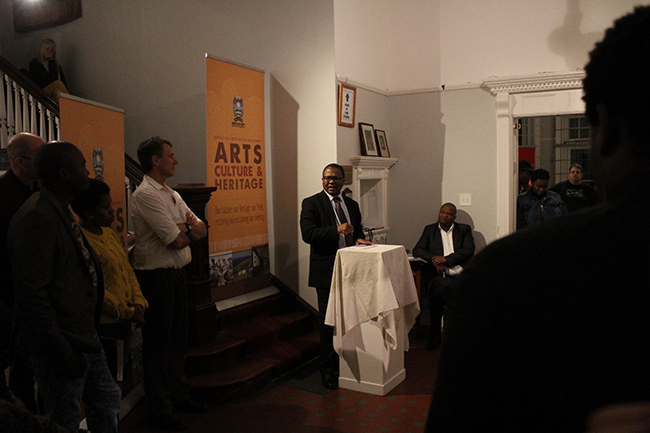Writing: Reviews & Think Pieces
Black modern art exhibited outside the De Beers Centenary Art Gallery for the first time.
The second day of the Umtiza Arts Festival, organized by the Buffalo City Metropolitan Municipality, was celebrated with the official opening of an ‘important’ exhibition on the eve of Africa Day. The annual festival is an event earmarked to promote the arts in a bid to make East London match what other big municipalities in major cities, such as Cape Town and Johannesburg, are doing in the creative sector. It was also the first time the valuable collection of black modern art belonging to the University of Fort Hare, known incorrectly as the ‘De Beers Collection’ after the De Beers Centenary Art Gallery housing it , had been exhibited outside its storage facility and made accessible to members of the public. The timing was perfect.
Councillor Marata officially opened the exhibition at Ann Bryant Main Gallery on behalf of the Mayor of the Buffalo City Metropolitan Municipality. In his remarks, he indicated that the Department of Arts and the municipality had made a commitment to the Festival as they realize that arts and culture are vital for uniting communities and creating employment opportunities. As such, they have identified arts as a key development strategy.
The keynote speaker for the night was Professor Sakhela Buhlungu, the Vice Chancellor of the University of Fort Hare. In his address, he emphasized the importance of art, which he said is crucial in building cities. He advised parents to stop channelling children to professions such as accounting, engineering and the medical field as they can also earn a living doing something as enjoyable as art. He noted that the artworks in the university’s collection were mostly collected from the black townships around the country during the apartheid era. Part of the collection contains some works of Gerard Sekoto – the “father” of black modernism in South Africa – made before he went into exile to Paris in 1947. Professor Buhlungu sees exhibiting his works and those of other black modern artists of Sekoto’s generation as a meeting point for these artists and the youth. However, he lamented the fact that George Pemba, who had even done illustrations for schoolbooks, died an ordinary person. He was not celebrated like the ‘tenderpreneur’ politicians of today that many young people see as role models. The same applies to most of the artists who made over 2 500 works in the collection.
However, the inspiring speeches given by the two guests of honour were not enough to conceal the substandard curatorial effort of Leon du Preez, the Curator of the Ann Bryant Gallery. The works of Pemba, Sekoto, Dumile Feni, and others on display deserve to be exhibited in a way that affords them more respect. To dump or bunch them in an exhibition of this nature is to undermine their legacy, and disrespect the South African art community and the young people who draw inspiration from their brilliant work. Notably, on the same floor as this collection was an artwork by Cecil Skotnes who was a mentor at Polly Street Art Centre in Johannesburg from 1952 to 1956. Some of the artists whose works were on display had been to that institution in that era. This presented the curator with an opportunity to start a meaningful dialogue, and not dilute the work by clustering it together. How about celebrating Pemba, a true son of the Eastern Cape in one of the province’s biggest cities? South Africa has a wealth of literature on art modernisms, including a strong revisionist attempt that contests the problematic histories. The curator should have done a bit more research to provide context, and make the works speak to members of the public coming to view them. The crucial question is how did such an important exhibition end up in a space that does not pay much attention to curatorial practices?
Before visiting the Ann Bryant Gallery, I did a bit of online research hoping to find more about this mysterious University of Fort Hare collection that is mostly inaccessible to the public. I could not find anything tangible. I had also been reliably informed that some researchers had found it hard to even access the works in the past. Therefore, the least I was looking forward to was to get a catalogue of the valuable works on display. I never thought the curator would inform me that he would put updates on the gallery’s website or Facebook page in the coming weeks. I did not know that I would have to scrutinize the labels myself to try to find out which of Pemba’s work is part of the University of Fort Hare collection and which one belongs to the Ann Bryant Gallery’s permanent collection.
It was a chance to highlight the excellence and achievements of black artists in the era of apartheid and an opportunity to celebrate Africa Day in style. Leon du Preez did not grab it with both hands. This could have been one of the finest exhibition shows ever had the curator done a bit more research and considered some of the discourses currently dominating the local cultural landscape.
Incorrectly referred to as the ‘De Beers Collection’, the University of Fort Hare Collection exhibition was on at the Ann Bryant Gallery.

Guest speaker Professor Sakhela Buhlungu, flanked by Leon du Preez (in white shirt) and Councillor Marata(seated)
Barnabas Ticha Muvhuti is a PhD History of Art candidate with the NRF/DST SARChI Chair Geopolitics and the Arts of Africa, Arts of Africa and Global Souths research programme headed by Prof Ruth Simbao at the Department of Fine Arts, Rhodes University, South Africa.
Keywords: modernism. South African Modernism, University of Fort Hare, Africa Day, De Beers Centenary Art Gallery, Ann Bryant Art Gallery, East London, Gerard Sekoto, George Pemba, Dumile Feni, Cecil Skotnes, Polly Street Art Centre, Buhlungu, De Beers, Buffalo City, Eastern Cape
Last Modified: Mon, 11 Feb 2019 10:22:44 SAST
